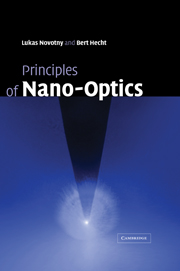Book contents
- Frontmatter
- Contents
- Preface
- 1 Introduction
- 2 Theoretical foundations
- 3 Propagation and focusing of optical fields
- 4 Spatial resolution and position accuracy
- 5 Nanoscale optical microscopy
- 6 Near-field optical probes
- 7 Probe–sample distance control
- 8 Light emission and optical interactions in nanoscale environments
- 9 Quantum emitters
- 10 Dipole emission near planar interfaces
- 11 Photonic crystals and resonators
- 12 Surface plasmons
- 13 Forces in confined fields
- 14 Fluctuation-induced interactions
- 15 Theoretical methods in nano-optics
- Appendix A Semianalytical derivation of the atomic polarizability
- Appendix B Spontaneous emission in the weak coupling regime
- Appendix C Fields of a dipole near a layered substrate
- Appendix D Far-field Green's functions
- Index
6 - Near-field optical probes
Published online by Cambridge University Press: 05 June 2012
- Frontmatter
- Contents
- Preface
- 1 Introduction
- 2 Theoretical foundations
- 3 Propagation and focusing of optical fields
- 4 Spatial resolution and position accuracy
- 5 Nanoscale optical microscopy
- 6 Near-field optical probes
- 7 Probe–sample distance control
- 8 Light emission and optical interactions in nanoscale environments
- 9 Quantum emitters
- 10 Dipole emission near planar interfaces
- 11 Photonic crystals and resonators
- 12 Surface plasmons
- 13 Forces in confined fields
- 14 Fluctuation-induced interactions
- 15 Theoretical methods in nano-optics
- Appendix A Semianalytical derivation of the atomic polarizability
- Appendix B Spontaneous emission in the weak coupling regime
- Appendix C Fields of a dipole near a layered substrate
- Appendix D Far-field Green's functions
- Index
Summary
Near-field optical probes, such as laser-irradiated metal tips, are the key components of near-field optical microscopes discussed in the previous chapter. No matter whether the probe is used as a local illuminator, a local collector, or both, the optical spatial resolution solely depends on the confinement of the optical energy at the apex of the probe. This chapter discusses light propagation and light confinement in different probes used in near-field optical microscopy. Where applicable we study fundamental properties using electromagnetic theories (see Chapter 15) and provide an overview of current methods used for the fabrication of optical probes. We hope to provide the basic knowledge to develop a clear sense of the potentials and the technical limitations of the respective probes. The most common optical probes are (1) uncoated fiber probes, (2) aperture probes, (3) pointed metal and semiconductor probes, and (4) nano-emitters, such as single molecules or nanocrystals. The reciprocity theorem of electromagnetism states that a signal remains unchanged upon exchange of source and detector. Therefore, it suffices to investigate a given probe in only one mode of operation. In the majority of applications it is undesirable to expose the sample surface on a large scale due to the risk of photo-damage or long-range interference effects complicating image reconstruction. Therefore, we will preferentially consider the local illumination configuration.
Dielectric probes
Dielectric, i.e. transparent, tips are an important class of near-field optical probes and are the key components for the fabrication of more complex probes, e.g. aperture probes.
- Type
- Chapter
- Information
- Principles of Nano-Optics , pp. 173 - 224Publisher: Cambridge University PressPrint publication year: 2006
- 2
- Cited by



